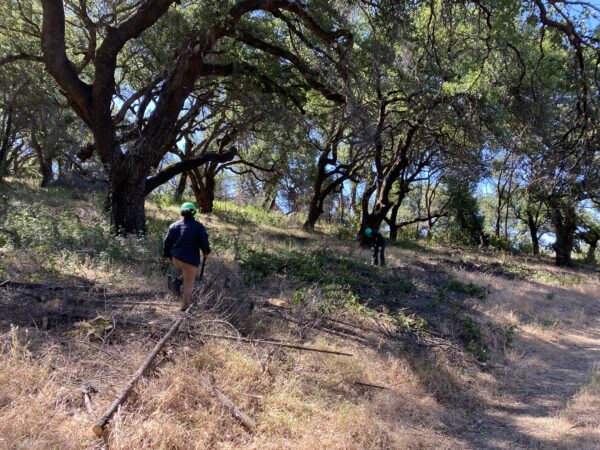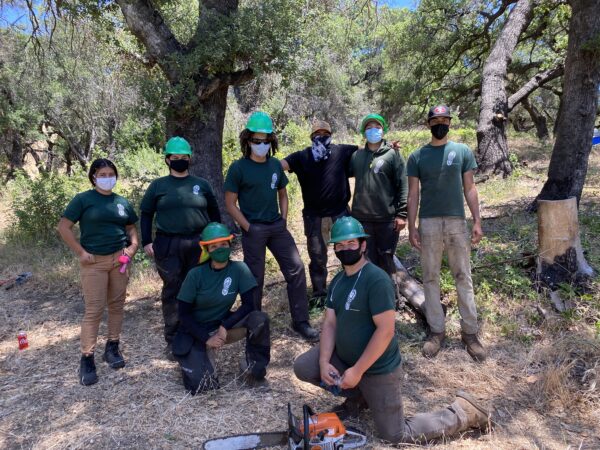October 27, 2022
Posted in: News Articles
Southeast of Santa Rosa, the upcoming Calabazas Creek Regional Park and Open Space Preserve is 1,290 acres of forests, grasslands, and creeks nestled in the Mayacamas Mountains. Although we transferred this property to Regional Parks in 2021, we’re in a transition phase where we’re supporting vegetation management projects to enhance forest health, reduce fire fuels, and help the land be better prepared in the event of future wildfires.
Ag + Open Space purchased the property in 2004, and we owned and managed it for nearly two decades before transferring it to Regional Parks to create a new public park and open space preserve. California giant salamanders and steelhead all call the preserve home.
Since the 2017 Nuns-Tubbs Fire, which burned the entire preserve, there are abundant signs of regrowth, which we continue to support with land management projects that increase wildfire resiliency, nurture the growth of large, mature conifer and hardwood trees, and remove invasive species.

With funding from a CAL FIRE grant through the Sonoma Valley Wildlands Collaborative, we’ve been working with the local conservation corps and contractors to implement shaded fuel breaks. A shaded fuel break is a corridor where the vegetation and other wildfire fuels built up after decades are thinned. The Calabazas shaded fuel break fulfills multiple purposes on the preserve, including increasing fire resilience, providing access in and out of the area for neighbors, removing Douglas firs, and reducing sudden oak death.
Shaded fuel breaks increase the spacing between trees and reduce ladder fuels in areas such as along roads or along ridge tops. In a non-wind-driven fire, pruning low-hanging branches allows fires to pass through the forest, keeping the fire on the forest floor burning at a relatively cool temperature. This reduces the risk of fire spreading into the canopy, which lowers the risk of a fire becoming more difficult to control.
So, what counts as ladder fuel? In this project, a Registered Professional Forester developed a plan to remove dead trees that were up to ten inches in diameter at breast height. They also directed the removal of all Douglas fir trees in the same diameter. In the absence of fire, Douglas fir trees have begun to dominate the preserve’s oak woodlands by shading oak trees and saplings. Removing younger Douglas fir trees allows more sunlight to reach the oak trees.

In addition, we worked with contractors to prune limbs on trees to ten feet above ground level to further create separation between ground fuels and the tree canopy. Treated vegetation was cleared by hand, and then cut into smaller pieces and scattered (“lop and scatter”), chipped, formed into burn piles, or hauled off-site.
This project also included thinning dead vegetation and ladder fuels next to areas that are potential locations for future prescribed burns. There are also several roads on the property that have been used by emergency responders during emergencies and during past wildfires to create fire breaks. In addition to shaded fuel breaks, this project helped remove vegetation along roadways to make emergency access easier.
We’re grateful to the many forestry workers who made this project possible. The shaded fuel break served as a training ground for several conservation corps, including Solano California Conservation Corps (CCC) Forestry Corps, the Conservation Corps North Bay, CCC Ukiah, and the Sonoma Supervised Adult Camp Probation Crew. Funding for the Solano crew’s work was generously provided through the CCC Forestry Corps. The Forestry Corps was established in 2019, and the Calabazas shaded fuel break was their first project. The contractors who helped us finish this project included Biswell Forestry, Spye General Engineering, and Sonoma-Marin Arborists.
We are one of the many who have cared for this land over time – it’s been home to Coast Miwok, Southern Pomo, and Wappo over the years, and was also part of Beltane Ranch, which was once owned by civil rights leader, Mary Ellen Pleasant. Calabazas is a living testament to the diverse history of our county, and we’re proud to care for this land that will help people to explore, learn, and find joy for many years to come.